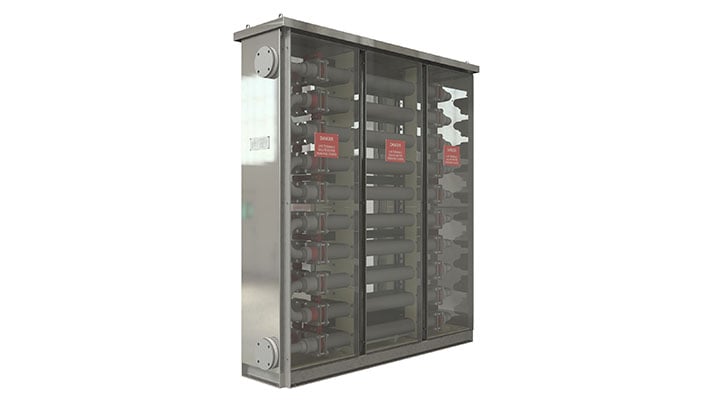The development of offshore wind power is booming. In 2021, the wind industry installed more than 6GW of new capacity, despite the pandemic. As we see this rapid rise continue, it is vital that technology is in place to support offshore wind, but also ensure its future is sustainable. In this article, Darren Dale, Director of Product Management at Evoqua Water Technologies, discusses the critical role of innovative marine growth prevention systems to the success of offshore wind.
Globally, offshore wind is fast becoming a leading source of renewable energy as governments work to meet climate change targets. The United Kingdom is leading the charge, currently owning around a quarter of all offshore wind projects worldwide, a capacity of over 38GW1 and this is set to grow. The UK government has set a target of being net zero by 2050 and central to this is generating enough energy from offshore wind to power every home in the UK, which is around 40GW.2
Further afield commitments are also strong. Last year, China was responsible for installing half of new global wind capacity.3 Another major economic power, the US, has set out its plans under the Biden Administration to expand offshore wind, with 30GW by 2030, enough to power ten million homes per year.4 As this expansion of wind power continues, it is more critical than ever that the technology helping to power offshore plants not only meets performance requirements but ongoing operational needs due in these complex environments.
Offshore wind technology is currently being established further from shore and grid connections as space is utilized and, with this, operators have had to overcome significant challenges. For the direct current (DC) required to make the wind farms operationally efficient, high-voltage direct current (HVDC) technology is utilized. HVDC transmission systems are housed on platforms in the sea, so as well as being subject to ever changing weather conditions and extremes of temperature, the technology faces fouling from marine species.
Marine species enter the HVDC systems in the sea water which is used in the technology’s cooling process. While seawater is a low-cost, easily accessible coolant, its downside is fouling by scaling, corrosion and biological growth, all of which cause damage to the HVDC systems over time and risks disruption to the generation of energy.
It goes without saying that sea water supports a wide spectrum of living organisms from bacteria through shellfish, fish, and small mammals. Cooling water intake screens remove the larger animals but sea anemones and shellfish like mussels, oysters and barnacles can easily breed in the warmth of the cooling system while algae and bacteria can form adherent biofilms reducing heat transfer rates, contributing to corrosion and even blocking pipes. This can severely shorten the life of affected equipment.
Marine growth prevention is, therefore, a vital tool in the control of heat exchanger fouling which costs the marine and offshore industry millions of pounds a year in maintenance downtime, wasted energy and cleaning chemicals. Traditionally, chemical treatments were used to treat marine fouling but, as well as being potentially hazardous and expensive, for unmanned offshore applications such as HVDC, plants need a reliable solution.
The answer is electrochlorination, the in-situ electrolytic generation of sodium hypochlorite for sea water. Evoqua has a patented design utilizing concentric tube electrolysis (CTE) cells, the Chloropac® system. The technology works by taking a small amount of water (28 usgpm or 6.5 m3/h) from a sea water cooling line which remains constantly under pressure. The water passes – at high velocity – through the electrolytic cells where part of the naturally occurring salt in sea water is converted to sodium hypochlorite. This dilute, safe solution of sodium hypochlorite is directly injected back into the water cooling line, preventing the growth of common marine species.
Evoqua’s Chloropac® system is therefore a critical technology for offshore applications. As well as effectively preventing marine growth to protect equipment, the CTE technology has to meet further unique requirements for the offshore environment. This includes reliability, low maintenance and high safety levels.
One of the key challenges for HVDC operators, is that the platforms are unmanned. They are monitored from shore, so therefore the progressive use of automation and digitalization to meet customers’ requirements is essential. Linked to this, maintenance needs must therefore be minimal. This is a trend that has been happening in oil and gas for decades, so CTE technology is already well established and tested in the offshore environment for more than 40 years. CTE enables this to happen as the Chloropac® system is self-cleaning. Operators can realize up to 20% cost savings in operational expenditure over the life of an HVDC system.
Going hand-in-hand with low maintenance requirements is reliability. Offshore operators need confidence they can get through to the next planned service of an electrochlorination system without a system failure. At a planned service they can then carry out pre-emptive maintenance if required. The Chloropac system offers this reliability as it is based on 10 years of experience in HVDC platforms. The lessons learned have led to designing with no single point of failure and attention to a strict reliability engineering approach.
The Chloropac system has further advantages
A further key requirement for the offshore industry and all technology commissioned is safety, due to the potentially hazardous environment. The Chloropac system is hazardous area approved and is capable of producing with typically low sea water temperatures. The technology is solely electrical driven, with no compressed air purging required through the system or pre-heating of feed seawater, allowing for safe for operation in an offshore location. An electrical supply and seawater feed is all that is required. These are unique offerings in the marketplace, eliminating the need and complexity of additional platform infrastructure.
1 EIC Insight Report Global Offshore Wind Nov 2021
2 https://www.gov.uk/government/publications/energy-white-paper-powering-our-net-zero-future/energy-white-paper-powering-our-net-zero-future-accessible-html-version
3 https://www.energylivenews.com/2021/03/04/china-installed-half-of-new-global-offshore-wind-capacity-in-2020/
4 https://www.energylivenews.com/2021/03/30/biden-presses-the-big-offshore-wind-expansion-button/
